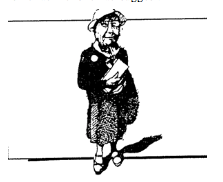Barbara Pym: A Very Private Eye: An Autobiography in Diaries and Letters; Edited by Hazel Holt and Hilary Pym; E. P. Dutton; New York; $19.95.
“Be more wicked, if necessary,” Barbara Pym’s agent once suggested as she revised her early novels and prepared to make her first wild dash through the gauntlet of London publishers. “Can you imagine an old spinster,” she responded (she was fast upon the venerable age of 36), “frowning anxiously over her MS. trying to be more wicked?” Mischievous, in her most spiteful moments perhaps she could be. Sarcastic? Maybe. But wicked, in the Mary McCarthy sense of the word? Never. The self-styled frump of modern letters and the nicest of British novelists, Pym was a committed traditionalist who dug in the heels of her sensible pumps to create a world of kindly curates and church bazaars several hedgerows off the thoroughfare of the beaten literary path. As one of the best modern-day comediennes of manners, hers was an art of the run in the stocking and the rouge too red, of the dramas and the traumas of a world smaller and more slatternly than life.
In her own life, however, Pym was not nearly as “excellent” an “excellent woman” (to use the epithet she herself applied to the superannuated old maids who putter about her novels scrabbling tea leaves and potato peels) as her fiction might lead us to believe. A Very Private Eye, a new pastiche of her letters and journals stitched together by her sister Hilary and literary executor Hazel Holt, gives us an unexpected picture of the more rakish side of Moll Pym. Beginning with a bang in 1932 with the journals she kept at St. Hilda’s at Oxford, and ending with a whimper, a postcard to Philip Larkin just a month short of her untimely death in 1980, the book is an immensely readable (if occasionally voyeuristic) peek through the keyhole into the private life of one of the “most under-rated writers of the centurv,” as the TLS heralded her.
“As I write this I have a Boncilla beauty mask on my face—tightening my skin—nice if uncomfortable feeling,” notes the sybaritic Pym of those early Oxford years. At 18 she was already considered more precocious than your average pigtailed, pennant-waving schoolgirl, and certainly not, as she was later to typecast herself, a whalebone corseted spinster in embryo. If not the vamp or the femme fatale, she was, for her age, a rather extroverted epicurean who, when torn between “a steam beauty bath” and Beowulf, almost in variably chose the former. For Oxford in the 1930’s, she lived her life in the fast-lane, as the large number of veiled references (widely meshed veil, at that) to her active love life suggest.
Sometime late in 1932 she developed an obsession, which became one of the profoundest influences on her personality, with a dashing young student whom she met somewhere in the vicinity of the pencil sharpener in the reading room of the Bodleian. Henry Harvey, dubbed Lorenzo, was to appear in nearly every journal entry from then on for the next eight years, monopolizing her attention to the exclusion of practically every other interest and exerting a rather demoralizing effect on her self confidence. For all of the attention he receives, Harvey remains, perhaps not surprisingly, only the blank screen on which she projects her sexual insecurities and therefore a somewhat shadowy figure in the book. From what one gathers, Lorenzo was something of a Lothario, highly critical of Pym’s appearance, intimidatingly cavalier, and much less interested in her, alas, than she in him.
In 1934 Harvey left Oxford and took a position at the University of Helsingfors, marrying Elsie Godenhjelm three years later. Pym was apparently bitterly disappointed and consequently struck up with them, in a spirit of retaliation, an arch and sarcastic correspondence, perhaps the most psychologically telling of the documents collected in the book. Adopting the facetious mannerism of referring to herself in the third person, she jabs tongue through cheek
when she describes for the Harveys’ benefit the personal squalor of the life she leads, now a lovelorn and colorless old dowager of 24. The skittish tone that these letters strike screeches like chalk dragged across a blackboard. In many of them, often addressed to “Darling Sister Elsie!” she damns herself with the shriveled-up sobriquet “Miss Pym,” whom she describes as “a spinster lady thought to have been disappointed in love.” “This so prudent sensible spinster,” this “stuffed-shirt,” as she refers to herself again and again, is “an old brown horse walking with slow majestic dignity” or in one letter “quite a dog,” who fritters away her time hooking rugs or tittering at the witticisms of her parson at teatime.
These I, I-who-have-nothing letters to the Harveys represent Pym at her worst, and she was never again to sink nearly as low into self-pity. What’s interesting about them is the insight they provide into the creation of Pym’s persona of society’s mousey supernumerary mouldering with her pussycats and unrequited passions somewhere in the dark wings of the great stage of life. As an elaborate charade of self deprecation executed in a broad commedia dell’arte, her correspondence with the Harveys marks the beginning of her persistent habit of fictionalizing her experiences to her own intensely unflattering disadvantage. Her relationship with Lorenzo really sowed the seeds of frustration and resentment that eventually flowered in the desiccated caricatures of dowdy “Miss Pym” who, feather dusters in hand, sidle about the pages of nearly all of her books. In other words, after reading this excellent collection of letters, her fiction can be seen as a gaudy and occasionally indulgent form of self-burlesque. cc
Image Credit: Fast-Living Frump

Leave a Reply